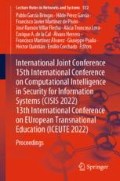Abstract
Websites are an appealing target for attackers due to the large number of users that make use of them, resulting in a massive exchange of information. Different types of vulnerabilities and anomalies can be present in this context, such as SQL Injection or DDoS attacks. To cope with all this, different types of Computational Intelligence-based techniques, capable of detecting these undesired events, are used. To this end, feature selection methods allow a dimensionality reduction that subsequently helps classification algorithms to achieve high performance results. In the present paper, both feature selection methods and classifiers are evaluated on an open dataset called CSIC2010 v2. Furthermore, a deep study of the features within this dataset has been carried out with the aim of extracting as much information as possible, generating two alternative datasets with this information that are employed for comparison purposes in this research. The interesting results that have been obtained contributes to an improvement on the detection of web attacks.
Access this chapter
Tax calculation will be finalised at checkout
Purchases are for personal use only
References
Atienza, D., Herrero, Á., Corchado, E.: Neural analysis of http traffic for web attack detection. In: Herrero, Á., Baruque, B., Sedano, J., Quintián, H., Corchado, E. (eds.) International Joint Conference, pp. 201–212. Springer, Cham (2015). https://doi.org/10.1007/978-3-319-19713-5_18
Bao, R., Zhang, K., Huang, J., Li, Y., Liu, W., Wang, L.: Research on website traffic prediction method based on deep learning. In: Jiang, D., Song, H. (eds.) SIMUtools 2021. LNICST, vol. 424, pp. 432–440. Springer, Cham (2022). https://doi.org/10.1007/978-3-030-97124-3_32
Bishop, C.: Pattern Recognition and Machine Learning. Information Science and Statistics. Springer, Berlin (2006)
Cortes, C., Vapnik, V.: Support-vector networks. Mach. Learn. 20(3), 273–297 (1995). https://doi.org/10.1007/BF00994018
ENISA: ENISA Threat Landscape Report 2020. Accessed 9 June 2020. https://bit.ly/3gdsB1O
Esteva, A., et al.: A guide to deep learning in healthcare. Nat. Med. 25, 24–29 (2019)
Giménez, C.T., Villegas, A.P., Álvarez Marañón, G.: HTTP DATASET CSIC 2010. Accessed 2 June 2022. https://www.isi.csic.es/dataset/
Gniewkowski, M., Maciejewski, H., Surmacz, T.R., Walentynowicz, W.: Http2vec: embedding of HTTP requests for detection of anomalous traffic. CoRR abs/2108.01763 (2021). https://arxiv.org/abs/2108.01763
Go, G.M., Bu, S.J., Cho, S.B.: Insider attack detection in database with deep metric neural network with Monte Carlo sampling. Logic J. IGPL (2022). https://doi.org/10.1093/jigpal/jzac007Jzac007
Hassani, H., Hallaji, E., Razavi-Far, R., Saif, M.: Unsupervised concrete feature selection based on mutual information for diagnosing faults and cyber-attacks in power systems. Eng. Appl. Artif. Intell. 100, 104150 (2021). https://doi.org/10.1016/j.engappai.2020.104150. https://www.sciencedirect.com/science/article/pii/S0952197620303870
Kent, J.T.: Information gain and a general measure of correlation. Biometrika 70(1), 163–173 (1983). https://doi.org/10.1093/BIOMET/70.1.163. https://academic.oup.com/biomet/article/70/1/163/240380
Luo, C., Tan, Z., Min, G., Gan, J., Shi, W., Tian, Z.: A novel web attack detection system for internet of things via ensemble classification. IEEE Trans. Ind. Inf. 17(8), 5810–5818 (2021). https://doi.org/10.1109/TII.2020.3038761
Magan-Carrion, R., Urda, D., Diaz-Cano, I., Dorronsoro, B.: Improving the reliability of network intrusion detection systems through dataset aggregation. IEEE Trans. Emerg. Topics Comput., 1 (2022). https://doi.org/10.1109/TETC.2022.3178283
Magán-Carrión, R., Urda, D., Diaz-Cano, I., Dorronsoro, B.: Towards a reliable comparison and evaluation of network intrusion detection systems based on machine learning approaches. Appl. Sci. 10(5), 1775 (2020). https://doi.org/10.3390/app10051775
Mirkovic, J., Reiher, P.: A taxonomy of DDoS attack and DDoS defense mechanisms. SIGCOMM Comput. Commun. Rev. 34(2), 39–53 (2004). https://doi.org/10.1145/997150.997156
Pinzón, C., Herrero, Á., De Paz, J.F., Corchado, E., Bajo, J.: CBRid4SQL: a CBR intrusion detector for SQL injection attacks. In: Corchado, E., Graña Romay, M., Manhaes Savio, A. (eds.) HAIS 2010, Part II. LNCS (LNAI), vol. 6077, pp. 510–519. Springer, Heidelberg (2010). https://doi.org/10.1007/978-3-642-13803-4_63
Sharafaldin, I., Lashkari, A.H., Ghorbani, A.A.: Toward generating a new intrusion detection dataset and intrusion traffic characterization. ICISSp 1, 108–116 (2018)
Sukchotrat, T.: Data mining-driven approaches for process monitoring and diagnosis. Ph.D. thesis, University of Texas (2008). https://www.proquest.com/dissertations-theses/data-mining-driven-approaches-process-monitoring/docview/276043339/se-2?accountid=14529
Urda, D., et al.: BLASSO: integration of biological knowledge into a regularized linear model. BMC Syst. Biol. 12(5), 361–372 (2018). https://doi.org/10.1186/s12918-018-0612-8
Wuest, T., Weimer, D., Irgens, C., Thoben, K.D.: Machine learning in manufacturing: advantages, challenges, and applications. Prod. Manuf. Res. 4(1), 23–45 (2016). https://doi.org/10.1080/21693277.2016.1192517
Yu, L., et al.: Detecting malicious web requests using an enhanced textcnn. In: 2020 IEEE 44th Annual Computers, Software, and Applications Conference (COMPSAC), pp. 768–777 (2020). https://doi.org/10.1109/COMPSAC48688.2020.0-167
Author information
Authors and Affiliations
Corresponding author
Editor information
Editors and Affiliations
Rights and permissions
Copyright information
© 2023 The Author(s), under exclusive license to Springer Nature Switzerland AG
About this paper
Cite this paper
Urda, D., Basurto, N., Kull, M., Herrero, Á. (2023). Evaluating Classifiers’ Performance to Detect Attacks in Website Traffic. In: García Bringas, P., et al. International Joint Conference 15th International Conference on Computational Intelligence in Security for Information Systems (CISIS 2022) 13th International Conference on EUropean Transnational Education (ICEUTE 2022). CISIS ICEUTE 2022 2022. Lecture Notes in Networks and Systems, vol 532. Springer, Cham. https://doi.org/10.1007/978-3-031-18409-3_20
Download citation
DOI: https://doi.org/10.1007/978-3-031-18409-3_20
Published:
Publisher Name: Springer, Cham
Print ISBN: 978-3-031-18408-6
Online ISBN: 978-3-031-18409-3
eBook Packages: Intelligent Technologies and RoboticsIntelligent Technologies and Robotics (R0)

